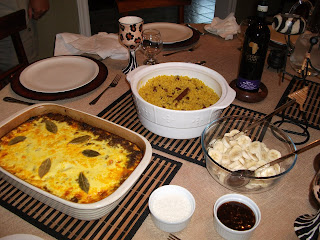
It was American night for our South African meal at Christa and Neil’s house in Oakville. The invited guests were us, my stepfather, Chris, who was visiting from Florida, and a co-worker of Neil’s who was visiting from Minnesota. It was also Canada’s Victoria Day, the un-definable holiday that evoked shrugs but was faithfully celebrated with parties, fireworks and a day off from work and school.
We sat outside on the deck, while our dinner cooked, munching on South African treats: Dried peaches, dried guava smear, nuts, beef biltong (dried shaved beef), and beef drowors (dried sausage). Kevin and I sat back contently - our kids happily playing with Christa and Neil’s children – and we discussed China and our recent trip there. Chris, who had worked and lived in China for years, charmed us with his infamous Chinese joke that he tells almost everyone he first meets.
When he got everyone’s attention – even waited for Christa to come out of the kitchen and sit down – he began. He started out by giving us a quick review of China/U.S. relations. He explained that in 1972 Nixon made a historical visit to China that led the way for China’s opening up to the West. Shortly after Nixon’s visit, Deng Xiaoping visited the United States where he was invited to a Texas barbeque.
“Deng was fascinated by the food,” Chris said. “He asked Nixon what everything was.” Chris pointed to imaginary food and stabbed the air with his finger. “
Zhi shi ma? What’s that? Deng Xiaoping asked. 'That’s a hotdog,’ Nixon said." Chris paused for comic effect. “Deng said, ‘We eat dog in China too, but not that part!’”
Chris beamed as everyone laughed. I laughed too even though I’d heard this joke a thousand times. Our kids had heard it a thousand times too. Once, at our house, Julia told this joke to some unsuspecting dinner guests.
When dinner was ready we ate inside in the dinning room. Dishes were spread out on the table like county fair pies competing for the blue ribbon. We each picked up a plate and piled them high with turmeric rice with raisins and Bobotie served with chutney, sliced bananas and diced tomato and onion sambal. It was all so delicious and John took so many helpings of the Bobotie that I was thankful Christa had made plenty. For dessert we had Melktert, or milk tart.
It was a lovely night, Americans talking about China while eating South African food and celebrating a Canadian holiday. It was the sort of thing I had come to expect living in the Toronto area. Christa pointed out that none of us were native to Canada, but we all felt connected to each other and to our surroundings.
I would leave Canada for China with the feeling I had that night: a mixture of quiet acceptance and warmth, a kind of peace and contentment. Thanks to Christa and Neil, and a country we once called home.
Recipes: Bobotie Ingredients
• 1 fairly thick slice crustless bread (white or wheat)
• Bay leaves
• 1 1/2 cups milk
• 2 teaspoons butter
• 2 onions, sliced
• 2 cloves garlic, crushed
• 5 teaspoons curry powder
• 2 teaspoons salt
• 5 teaspoons chutney
• 1 tablespoon smooth apricot jam
• 1 tablespoon Worcester sauce
• 1 teaspoon turmeric
• 5 teaspoons brown vinegar
• 2 1/4 pounds ground beef, mutton, or lamb (raw mince)
• 1/4 cup green seedless grapes (sultanas)
• 3 eggs
• Pinch each salt and turmeric
Preparation
• 1
Soak bread in milk.
• 2
Heat oil and butter in large pan and fry onions and garlic. When onions are soft, add curry powder, salt, chutney, jam, Worcester sauce, turmeric and vinegar and mix well.
• 3
Drain and mash bread and reserve milk.
• 4
Add bread to pan together with meat and grapes. Cook over low heat, stirring, and when meat loses its pinkness, remove from stove. Add 1 beaten egg, mix well, then spoon into a greased 11 x 7 inch baking dish and level the top.
• 5
Beat remaining eggs with reserved milk (you should have about 10 ounces) and the salt and turmeric. Pour over meat mixture and put a few bay leaves on top. Stand dish in a larger pan of water (this is important to prevent drying out) and bake, uncovered at 350 degrees F for 1 hour or until set.
• 6
Serve with yellow rice, chutney, sliced bananas and a diced tomato and onion sambal.
Yellow Rice
Yellow rice is eaten with the Cape Malay dish called Bobotie.
Ingredients
2 cups of rice
¾ cup raisins, soaked in water for 20 minutes, then drained
1 teaspoon of turmeric
a dash of salt
2 sticks of cinnamon
Instructions on how to make it
Place all the ingredients, including the raisins in about 750ml of water, bring to the boil and simmer for 15 to 20 minutes. If there is still excess water in the pot when the rice is tender, pour it out carefully.
Dot the rice with a few blobs of butter and give it a sprinkling of cinnamon sugar (come on Penny, a little sugar and a little cinnamon powder, mixed together).
Cover and keep warm.
South African Melktert (Milk Tart) Ingredients
• 3 tablespoons butter, melted
• 1 cup white sugar
• 3 egg yolks
• 1 cup cake flour
• 1 teaspoon baking powder
• 1/4 teaspoon salt
• 1 teaspoon vanilla extract
• 4 cups milk
• 3 egg white
• 1 tablespoon cinnamon sugar
Directions
1. Preheat the oven to 375 degrees F (190 degrees C). Coat a 9 inch deep dish pie plate with vegetable oil cooking spray.
2. In a large bowl, mix together the butter and sugar until smooth. Add the egg yolks and beat until light and fluffy. Sift in the cake flour, baking powder and salt, and stir until well blended. Mix in the vanilla and milk. In a separate bowl, whip the egg whites to stiff peaks using an electric mixer. Fold into the batter. Pour into the prepared pie plate, and sprinkle cinnamon sugar over the top.
3. Bake for 25 minutes in the preheated oven, then reduce the temperature to 325 degrees F (165 degrees C). Continue to bake for 25 to 30 minutes, or until the center is set when you gently jiggle the pie. Serve hot or cold.

